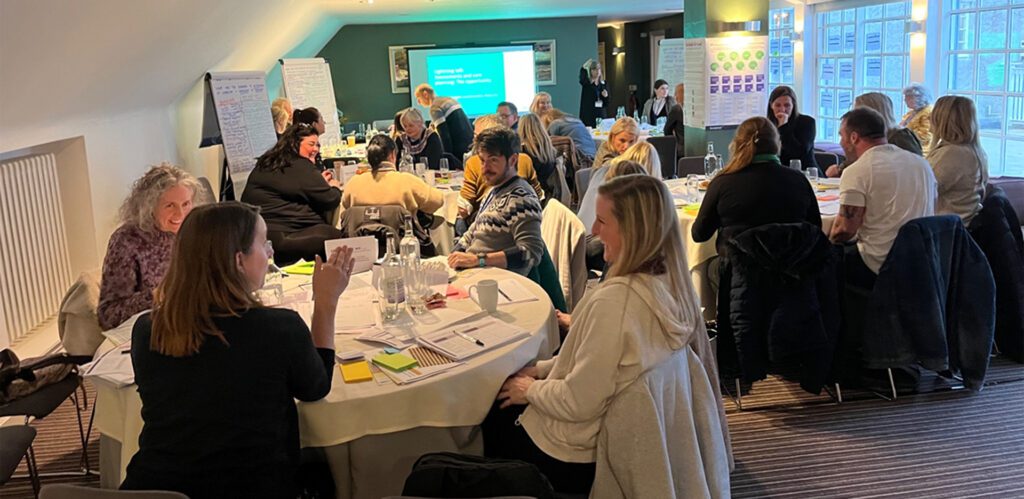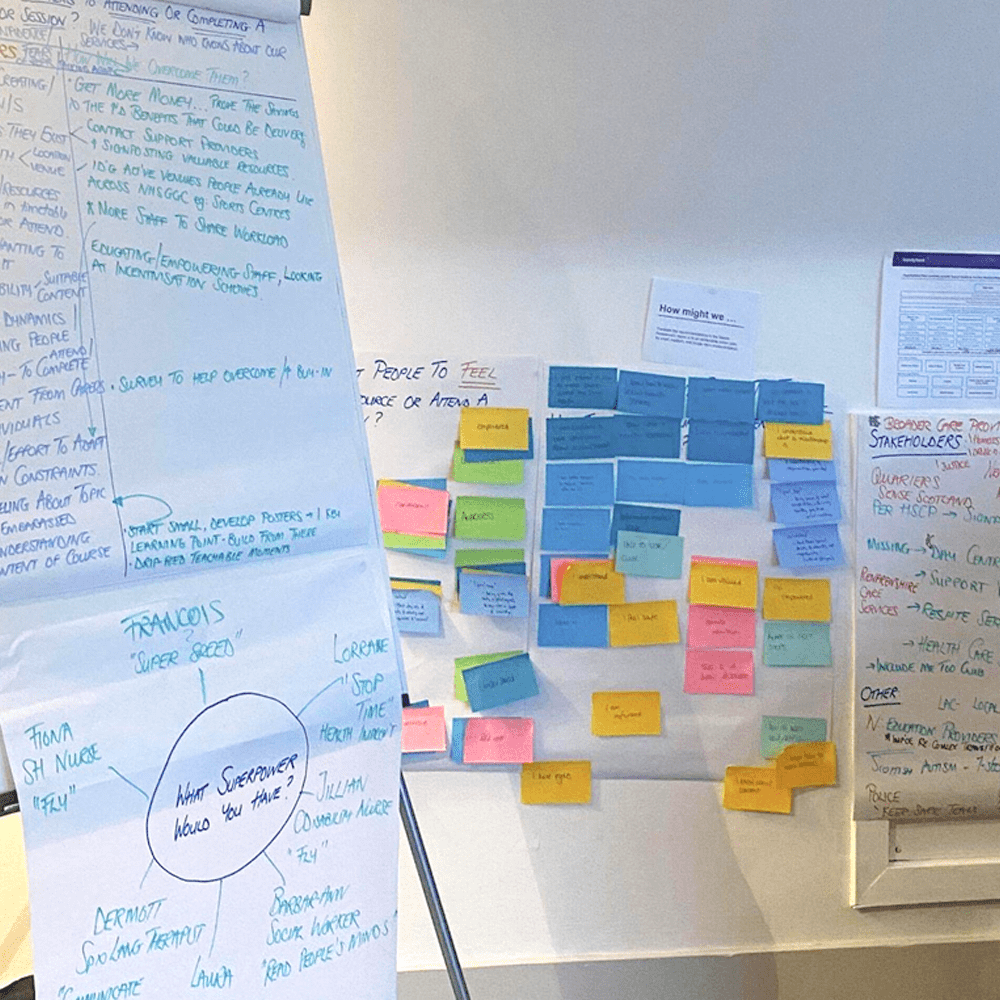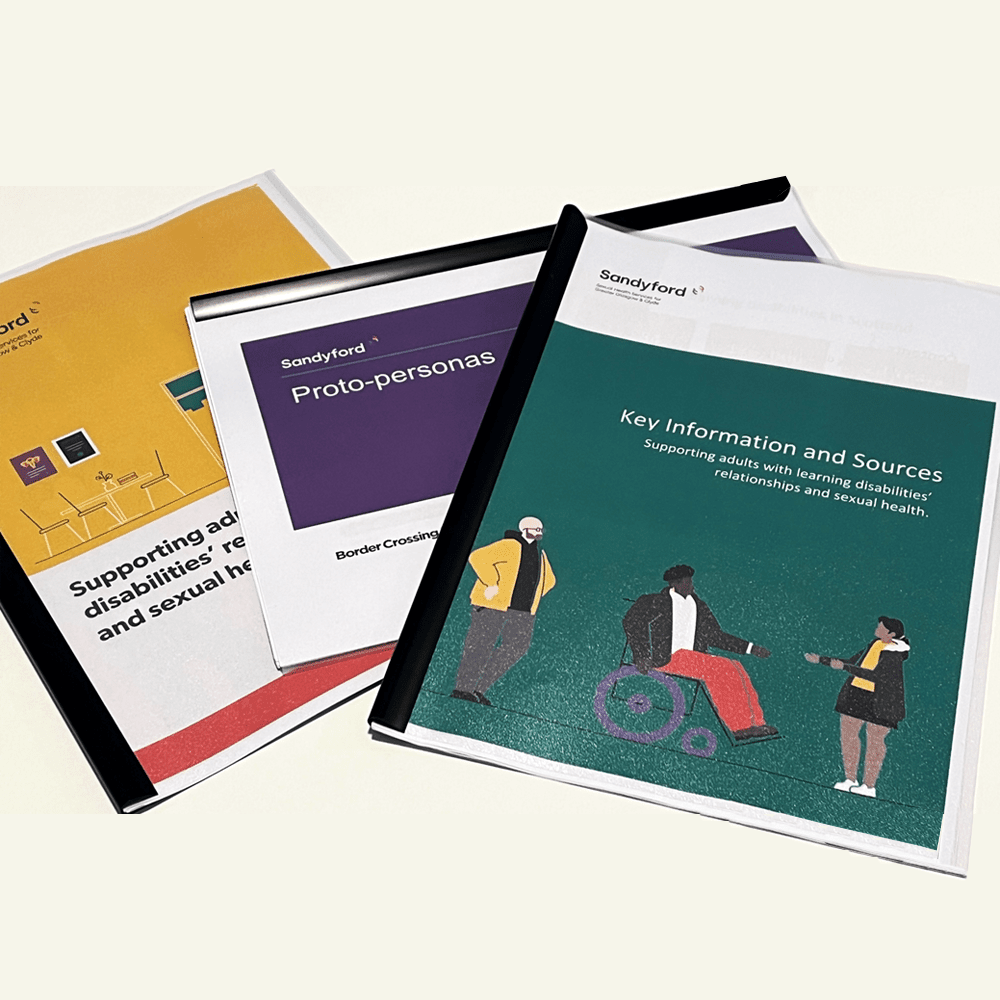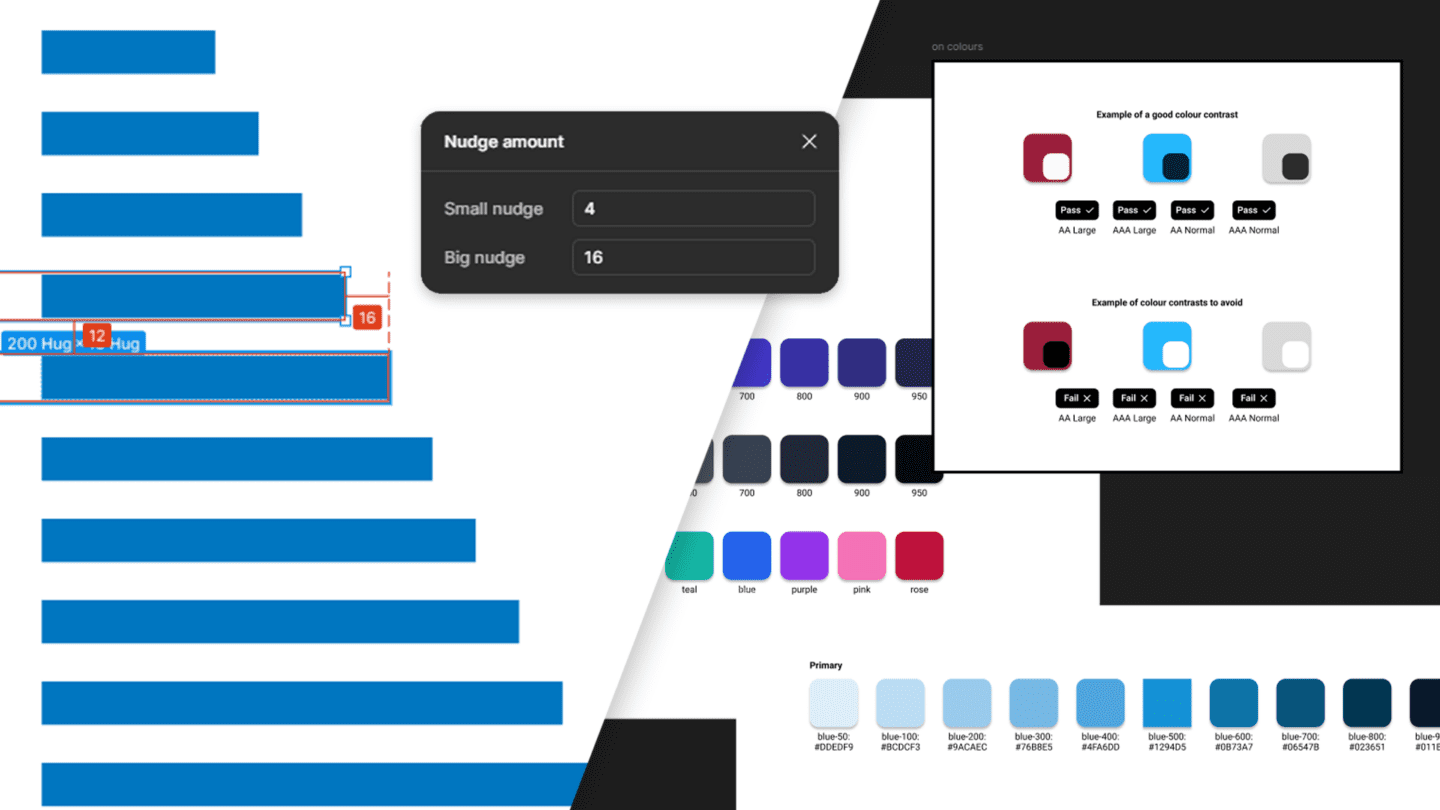
Sandyford Sexual Health Service published a tender for a facilitator to develop and lead an engagement event. The purpose of this event was to identify how best to translate the recommendations contained in a Needs Assessment report into an achievable action plan for short, medium, and longer term implementation.
As this was a project for a public sector organisation, we wanted to ensure what we did before, during, and after the event was aligned with the Scottish Approach to Service Design (SAtSD) principles.
Developed by the Scottish Government’s Digital Directorate, the SAtSD describes:
“Design is a way of exploring the problem space openly, collaboratively and with users, before a solution or service is decided.”
This strongly reflected the ethos and purpose of the event. This is why, now that this project is complete, we’re keen to share any potentially reusable insights, methods, and outputs with others.
In this post, we’ll provide an overview of two key outputs that were developed post-event, focussing on why and how these key deliverables were produced. We’ll also detail the additional links and resources that we benefited from throughout this project.
What you learn should inform what you do next …
One of the key learning points from the event was that:
Existing resources need to be reviewed and evaluated by a broad range of stakeholders. This should include adults with lived experience, parents, carers, specialist practitioners, such as speech therapists, health and social care staff, support workers, etc.
Given the volume of resources to be reviewed, this would require a substantial volume of volunteers who would most likely be working asynchronously. This was likely to pose challenges in terms of applying a consistent evaluation framework that was relevant to resources that needed to meet the needs of such a:
- Broad range of consumers
- Disparate range of emotional, as well as functional needs
So, this led us to consider how might we harness the disparate knowledge and expertise of a diverse range of stakeholders whilst ensuring a consistent approach to evaluating content.

Focussing on outcomes: Identifying the guiding principles that matter most
We believe that having a strong set of guiding principles, that everyone buys into, can really help foster alignment and establish a shared focus.
We regularly work with clients to define in-house principles that are:
- Aligned to brand strategies and organisational objectives
- Focussed on the outcomes end-users must experience if these are to be achieved or realised.
For the event, we ran a series of collaborative design exercises that were focused on exploring what these could be. This was achieved by investigating what participants in the room wanted people to think, feel, and do when using a resource or attending a workshop or session. Given the volume and variety of stakeholders in the room, this encompassed a broad range of:
- Stakeholders, including adults with a learning disability, their personal networks, staff who had no formal training, and specialist staff.
- Potential scenarios and types of resources, for example, an advice leaflet for parents on how to talk about puberty with their child or a workshop equipping staff with new trauma response skills
This meant that there was an incredibly rich source of data to base these principles on.
Once we had cleansed, coded, and analysed the outputs from the event, a clear set of principles started to emerge. The highest frequency keywords were used to inform the title of each principle. Once these were identified, the next step was to ensure relevant unpacking text that was written from the point of view of whoever was consuming the content. This was achieved by synthesising the long-form text that accompanied each of these keywords.
Ultimately, the aim of this deliverable was to:
- Provide a user centred view on what functional and emotional outcomes resources should help affect
- Ensure a broad range of points of view are always kept front and centre throughout the process of evaluating, updating, or producing new resources



We’ve detailed the user experience principles that were defined following the event below:
Confident
I feel confident having conversations about relationships and sexual health.
Safe
I feel secure and can talk freely without fear, knowing that I’m in a safe and confidential environment.
Comfortable
I feel comfortable discussing relationships and sexual health.
Valued
I feel like my experiences and knowledge are understood and responded to.
Respected
Everyone/everything I interact with treats me like an independent person with expertise in my own thoughts, emotions, and needs.
Empowered
I feel like I understand everything I need to and know how to use this knowledge in the future.
Supported
Should I need it, I know where to turn for further advice and support.
Reassured
I feel at ease with how I feel and the actions I should take next.
Included
I feel involved and part of a positive community who are focussed on helping improve things.
Informed
I understand and know more about the problems and topics I am dealing with.

These have been:
- Shared with all key stakeholder organisations and participants,
- Positioned as a starting point that can be cloned, customised, and iterated on as required.
Over time these principles could be integrated with an evaluation and production checklist for new resources and workshops.
Establishing consistency: creating an evaluation and production checklist for new resources and workshops

Another deliverable that was developed post-event was the evaluation and production checklist. The purpose of this deliverable was to provide a set of simple questions that could be used by cross-functional teams to co-evaluate and co-produce new resources and workshops.
Like the user experience principles, we wanted to ensure that anyone who was part of a working group post-event, or those from the wider profession, would have a starting point for critiquing the resources that currently exist. To ensure consistency, there needed to be a standardised approach to assessing resources even though different people from disparate backgrounds could be doing the assessment.
The checklist categories and questions were identified based on:
- Key points that were made and then captured by facilitators throughout group discussions,
- Frequent responses to exercises conducted on the day, e.g. formats, adaptability, etc.
- Best practice.
We’ve detailed the questions that could be integrated into a standardised evaluation and production checklist for evaluating and/or creating new resources below:
Relevance
Is the target audience for the content clearly articulated?
Has the content been co-produced with this audience?
Has the content been tested / checked for its target audience?
Does the content contain first-hand / personal stories?
Does this content contain practical tips and examples?
Accuracy
Is this content up to date?
Is the topic adequately covered?
Are relevant services and points of contact signposted?
Who should ensure this content is maintained/kept up-to-date?
Clarity
Is this content structured and formatted appropriately?
Is all text supported by visual/interactive elements?
Could this content be deemed to be “easily read” / in an “easy read” format?
Is this content available in multiple formats?
Is the content accessible to a broad range of service users?
Outcomes
Is this content likely to adhere to our experience principles?
Although written specifically for Sandyford, these questions are high-level and project/organisation agnostic. So, we hope they can be used and adapted by others to make the process of evaluating and/or creating high-quality resources and courses a bit easier.


Sandyford is committed to ensuring that everyone enjoys good and positive sexual health. Their vision is perfectly aligned with the Scottish Approach to Service Design. Which is why everyone from Sandyford and the broader working group were so keen to share these outputs post-event.
So, if you’re looking to define a set of user experience principles or define an evaluation and production checklist that guides a broad range of volunteers we’d highly recommend reviewing the outputs produced following this engagement event.
And, if you’d like to learn more, or discuss either of these deliverables in further detail please feel free to contact us.
Further information and resources
Throughout this project we found the following resources incredibly helpful:
Scottish Commission for People with Learning Disabilities: “How’s Life?” Reports
Scottish Commission for People with Learning Disabilities: Relationships Matter Report
The Keys to Life: Scotland’s learning disability strategy
Scottish Government: Learning/intellectual disability and autism: transformation plan
World Health Organisation Technical Consultation on Sexual Health (28-31 January 2002)
Public Health Scotland: Gender-based Violence and Learning Disability: Guidance for practitioners
Mencap: Sexuality – research and statistics
Photo Symbols – A photo library for Easy Read information and 5,000 pictures featuring actors with learning disabilities. Also provides templates and training for Easy Read documents. Has a team of expert advisors with learning disabilities that meet every month. Contains images relating to relationships and sexual health (Sexual abuse) and the ability to turn on safe search.
Making Content Usable for People with Cognitive and Learning Disabilities


